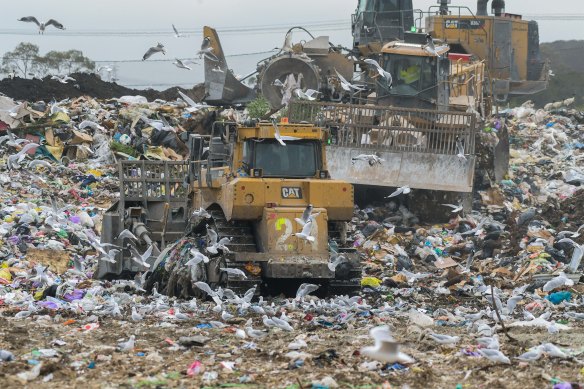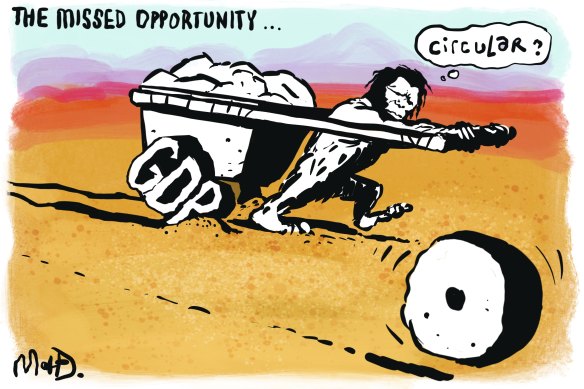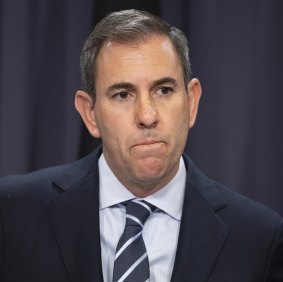This was published 9 months ago
Opinion
This is the key to happiness and economic prosperity
Millie Muroi
Economics WriterFor as long as humans have walked the earth, we’ve grappled with this dilemma: how to satisfy our unlimited wants and needs with limited resources. Eventually, people started putting pen to paper, and called the study of this problem “economics.”
Over time, we’ve become better at making – and doing – more: by piecing together machines that can dig more out of the ground, stripping the soil, and producing all sorts of foods, gadgets and shelter. Our ancestors would be shocked walking through the supermarket, and trawling online, at the seemingly infinite choices at our fingertips today.

Many of the materials used in the economy end up buried in landfill or drifting around in the atmosphere.Credit: Joe Armao
But all this has come at a cost – which we haven’t been particularly good at factoring in.
For the past few centuries, we’ve measured our success, economically speaking, mostly by how much we’re able to produce. The bigger the amount (often measured through gross domestic product, or GDP) the better.
In simply prioritising greater output, though, we’ve been pumping out emissions, producing massive amounts of waste and damaging land and waterways. We’ve been scoring own goals, even as we press forward in this seemingly never-ending game of producing more.
Now, the solution isn’t necessarily to rewind the work we’ve done. But it does pay to look back in time. For many indigenous communities, it has been the case for millennia that people take only what they need, leaving enough for remaining resources to regenerate, and reusing and repairing things rather than tossing them away.
These principles are also at the heart of the concept of a “circular economy”.
Our economy now is mostly “linear”, meaning we tend to take raw materials from the earth, make things out of them, then pretty quickly dispose of them when those things start falling apart. A lot of the valuable materials we take from the land end up buried in landfill or drifting around in the atmosphere or our oceans – which, apart from harming the environment, is a problem when we’re on a planet with limited resources.
Now, most of us have a decent understanding of recycling. You probably divvy-up your hard plastics from your soft plastics, and you might even have a compost bin or worm farm.
Australia’s overall material recycling rate in the 2021–22 period was about 63 per cent – or 1568 kilograms of recycled material for each person, up from 57 per cent in 2011-12. It’s an industry which added roughly $5 billion in value to the Australian economy, more than 30,000 jobs, and paid over $2.5 billion in wages and salaries in 2021-22. And there’s room to grow.

Credit: Matt Davidson
But the circular economy starts long before we decide to toss things out. It’s about designing things in ways that create less waste: from the process of making them (how can we limit by-products like carbon dioxide when building a house, or make a car using less material?) to designing goods that last the distance, or run more efficiently (how can we make T-shirts that hold their shape for years, or planes that run on less fuel and cough out less emissions?)
It’s also about a mindset shift – which could actually make us happier. In our consumption-led economy (household spending drives more than half of our economic growth), it’s easy to fall into the trap of buying things. Ads spruiking that thing you really need are everywhere. Whether it’s the newest iPhone, that cute outfit you’ve been eyeing up, or that power tool which will definitely complete your collection, the dopamine hit when you walk away with a new item is a fuzzy feeling many of us are familiar with.
But that excitement tends to wane over time, buyer’s remorse can creep in, and we often end up with a lot of clutter which we compare to other people’s clutter and fall into an endless cycle of sorting through.
Being more conscious about our purchases, buying things that are made sustainably, and thinking about how to extend the life of our possessions, are good places to start. “Buy Nothing” groups where people give away things they no longer need, and repairing things rather than throwing them away, are ways we can save money and feed into this circular economy.

Treasurer Jim Chalmers has requested a Productivity Commission inquiry into the circular economy.Credit: Alex Ellinghausen
The way we consume things is undeniably a game-changer. But the government and the country’s businesses also have a role. In October 2022, Australia’s environment ministers committed to speeding up the transition to a circular economy by 2030.
This week, the Productivity Commission opened up its desk to submissions for its inquiry into Australia’s opportunities in the circular economy. Requested by Treasurer Jim Chalmers, the inquiry will look into ways Australia can “improve materials productivity and efficiency in ways that benefit the economy and the environment.”
While we’ve tended to fixate on how we can improve the productivity of workers, international studies suggest a more circular economy can lead to higher economic growth and productivity, largely by boosting how productive we are with our inputs: essentially making more with a given amount of raw materials.
Australia has the fourth-lowest rate of materials productivity among OECD countries, generating $US1.20 of economic output for each kilogram of materials we consume. That’s less than half of the OECD benchmark of $US2.50.
Of course, it’s important to remember Australia is a bit of an outlier. We’re a highly resources-driven economy, with vast amounts of land separating us from our cows, sheep, mines and one another. While we can make transport less wasteful, achieving 100 per cent circularity is practically off the table.
Moving towards a more circular economy, though, is a worthwhile exercise – and one we’ve been making progress towards. Our material productivity has increased from $1.45 generated from a kilo of materials in 2010, to nearly $1.60 a kilogram in 2023, and we’re generating a bit less waste per person than we were a couple of decades ago.
Since the industrial revolution, we’ve rapidly fattened up our economy by pumping out products and consuming more. While going around in circles is generally a bad thing, the best way forward might be just that.
The Business Briefing newsletter delivers major stories, exclusive coverage and expert opinion. Sign up to get it every weekday morning.